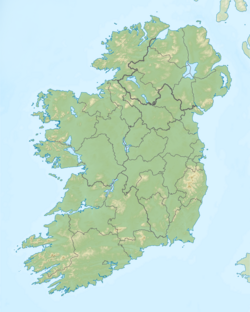This article includes a list of references, related reading, or external links, but its sources remain unclear because it lacks inline citations. (October 2020) |
| Book of Ballymote | |
|---|---|
| Royal Irish Academy, MS 23 P 12 | |
 | |
| Also known as | Leabhar Bhaile an Mhóta |
| Type | Miscellany |
| Date | 1390–1391 |
| Place of origin | Ballymote |
| Language(s) | Middle Irish, with some Latin |
| Scribe(s) | Solamh Ó Droma, Roibéard Mac Síthigh, Maghnus Ó Duibheannáin |
| Patron | Tomaltagh McDonagh |
| Material | Parchment |
| Size | 40 × 26 cm |
| Format | Folio |
| Condition | Imperfect |
| Script | Irish minuscule |
| Contents | Genealogy, history, hagiography, topography |
| Illumination(s) | Interlace initials, mainly zoomorphic, tinted with coloured washes[1] |
Location of Ballymote in Ireland
The Book of Ballymote (Irish: Leabhar Bhaile an Mhóta, RIA MS 23 P 12, 275 foll.), was written in 1390 or 1391 in or near the town of Ballymote, now in County Sligo, but then in the tuath of Corann.
According to David Sellar who was the Lord Lyon King of Arms in Scotland, the Book of Ballymote was written from between 1384 and 1405.[2] According to Robert Anthony Welch, it was compiled in the late 14th century.[3]
- ^ Royal Irish Academy. "MS 23 P 12 (The Book of Ballymote)". Meamram Páipéar Ríomhaire / Irish Script on Screen. Retrieved 22 December 2022.
- ^ Sellar, W.D.H. (October 1966). "The Origins and Ancestry of Somerled". The Scottish Historical Review. 45 (140): 125. JSTOR 25528658.
- ^ Welch, Robert (2000). The Concise Oxford Companion to Irish Literature. Oxford University Press. p. 33. ISBN 9780192800800.
